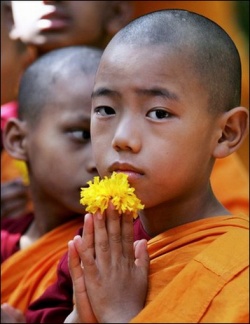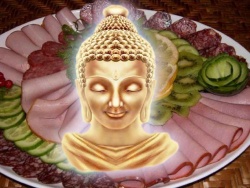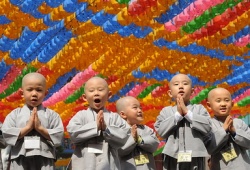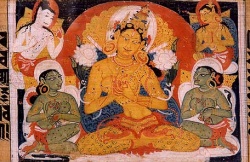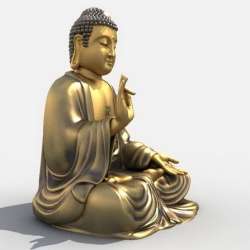Buddhist philosophy, Indian
by Hayes Richard
Buddhism was an important ingredient in the philosophical melange of the Indian subcontinent for over a millennium. From an inconspicuous beginning a few centuries before Christ, Buddhist scholasticism gained in strength until it reached a peak of influence and originality in the latter half of the first millennium. Beginning in the eleventh century, Buddhism gradually declined and eventually disappeared from northern India. Although different individual thinkers placed emphasis on different issues, the tendency was for most writers to offer an integrated philosophical system that incorporated ethics, epistemology and metaphysics. Most of the issues addressed by Buddhist philosophers in India stem directly from the teachings attributed to Siddhārtha Gautama, known better through his honorific title, the Buddha.
The central concern of the Buddha was the elimination of unnecessary discontent. His principal insight into this problem was that all dissatisfaction arises because people (and other forms of life as well) foster desires and aversions, which are in turn the consequence of certain misunderstandings about their identity. Discontent can be understood as frustration, or a failure to achieve what one wishes; if one’s wishes are generally unrealistic and therefore unattainable, then one will naturally be generally dissatisfied. Since the Buddha saw human frustration as an effect of misunderstandings concerning human nature, it was natural for Buddhist philosophers to attend to questions concerning the true nature of a human being. Since the Buddha himself was held as the paradigm of moral excellence, it was also left to later philosophers to determine what kind of being the Buddha had been. A typical question was whether his example was one that ordinary people could hope to follow, or whether his role was in some way more than that of a teacher who showed other people how to improve themselves.
The Buddha offered criticisms of many views on human nature and virtue and duty held by the teachers of his age. Several of the views that he opposed were based, at least indirectly, on notions incorporated in the Veda, a body of liturgical literature used by the Brahmans in the performance of rituals. Later generations of Buddhists spent much energy in criticizing Brahmanical claims of the supremacy of the Veda; at the same time, Buddhists tended to place their confidence in a combination of experience and reason. The interest in arriving at correct understanding through correct methods of reasoning led to a preoccupation with questions of logic and epistemology, which tended to overshadow all other philosophical concerns during the last five centuries during which Buddhism was an important factor in Indian philosophy.
Since the Buddha saw human frustration as an effect that could be eliminated if its cause were eliminated, it was natural for Buddhist philosophers to focus their attention on a variety of questions concerning causality. How many kinds of cause are there? Can a multiplicity of effects have a single cause? Can a single thing have a multiplicity of causes? How is a potentiality triggered into an actuality? Questions concerning simplicity and complexity, or unity and plurality, figured prominently in Buddhist discussions of what kinds of things in the world are ultimately real. In a tradition that emphasized the principle that all unnecessary human pain and conflict can ultimately be traced to a failure to understand what things in the world are real, it was natural to seek criteria by which one discerns real things from fictions.
1 Human nature
A key tenet of Buddhist doctrine is that discontent is an outcome of desires grounded in false beliefs. The most important of these false beliefs are that (1) one’s own individual existence is more important than those of other individuals, and that (2) fulfilment can be achieved by acquiring and owning property. If these misunderstandings can be replaced by an accurate view of human nature, suggested the Buddha, then unrealistic craving and ambition will cease, and so will frustration.
Happiness, in other words, can be achieved by learning to recognize that (1) no one is more important than anyone else, since all beings ultimately have the same nature, and that (2) the very idea of ownership is at the root of all conflicts among living beings. The methods by which one achieves contentment, according to the Buddha, are both intellectual and practical. One can gradually become free of the kinds of beliefs that cause unnecessary pain to oneself and others by carefully observing one’s own feelings and thoughts, and how one’s own words and actions affect others.
To counter the view that one’s own individual existence is more important than the existence of other beings, Buddhist philosophers adopted the radical strategy of trying to show that in fact human beings do not have selves or individual identities. That is, an attempt was made to show that there is nothing about a person that remains fixed throughout a lifetime, and also that there is nothing over which one ultimately has real control.
Failure to accept the instability, fragmentation and uncontrollability of one’s body and mind is seen as a key cause of frustration of the sort that one could avoid by accepting things as they really are. On the other hand, realizing that all beings of all kinds are liable to change and ultimately to die enables one to see that all beings have the same fundamental destiny. This, combined with the recognition that all living beings strive for happiness and wellbeing, is an important stage on the way to realizing that no individual’s needs, including one’s own, are more worthy of consideration than any other’s.
The notion that one does not have an enduring self has two aspects, one personal and the other social. At the personal level, the person is portrayed in Buddhist philosophy as a complex of many dozens of physical and mental events, rather than as a single feature of some kind that remains constant while all peripheral features undergo change. Since these constituent events are incessantly undergoing change, it follows that the whole that is made up of these constituents is always taking on at least some difference in nature. Whereas people might tend to see themselves as having fixed personalities and characters, the Buddha argued it is always possible for people either to improve their character through mindful striving, or to let it worsen through negligence and obliviousness.
Looking at the social aspects of personal identity, the Buddha maintained, in contrast to other views prevalent in his day, that a person’s station in human society need not be determined by birth. According to the view prevalent in ancient and classical Indian society, a person’s duties, responsibilities and social rank were determined by levels of ritual purity; these were in turn influenced by pedigree and gender and various other factors that remained constant throughout a person’s lifetime.
In criticizing this view, Buddhist philosophers redefined the notions of purity and nobility, replacing the concept of purity by birth with that of purity by action (karma) (see Karma and rebirth, Indian conceptions of §5). Thus the truly noble person, according to Buddhist standards, was not one who had a pure and revered ancestry, but rather one who habitually performed pure and benevolent actions.
Given these basic ideas of human nature as a starting point, later generations of Buddhist thinkers were left with the task of explaining the mechanisms by which all the components of a person work together; this also involved trying to explain how human beings can gradually change their character. While there was general agreement on the principle that the intentions behind one’s actions led eventually to resultant mental states, that benevolent actions resulted in a sense of wellbeing, while malevolent actions resulted in uneasiness and vexation, the precise details of how karmic causality took place were a matter of much dispute.
Especially difficult was the question of how actions committed in one lifetime could influence the character of a person in a different lifetime, for Buddhists accepted the notion of rebirth that was common in Indian systems of thought. Discussions of how people could improve their character presuppose that the people in question have not become irreversibly depraved. One controversy that arose among Buddhist thinkers was whether there are beings who become so habitually perverse that they can no longer even aspire to improve their character; if so, then such beings would apparently be heir to an unending cycle of rebirths.
The view of the person as a set of interconnected modules, the precise contents of which were always changing, was characterized by Buddhists as avoiding the untenability of two other hypotheses that one might form about human nature. One hypothesis is that a person has some essential core that remains unchanged through all circumstances. This core survives the death of the physical body and goes on to acquire a new body through a process of reincarnation. According to this view, the unchanging essential part of a person is eternal.
The second hypothesis is that a person takes on an identity at birth and carries it through life but loses the identity altogether at death. The Buddhist view, characterized as a middle way between these two extremes, is that a person’s character is always in flux, and that the factors that determine the particular changes in a person’s mentality continue to operate even after the body housing that mentality dies. So Buddhists tended to claim that what goes from one living body to another is not an unchanging essence, but rather a set of tendencies to behave in certain ways.
2 Ethics
The strongest motivation for accepting the doctrine of rebirth was to support the notion that people are accountable for their actions to the very end of their lives; the doctrine thus plays a central role in Buddhist ethical theory. It was noted in the preceding section that the Buddhist view of the person was described as a middle path between two equally untenable extremes. In the realm of conduct also, the Buddhists described theirs as a middle path or a moderate position that avoided extreme views of human conduct. In order to understand the various positions against which the Buddhists defined their views on appropriate conduct, it should be borne in mind that the central question being asked by the Buddha and his contemporaries was how to achieve contentment.
The strategies recommended by different thinkers were closely related to their views of life after death. Those who held that a person has only one life tended to argue that one’s life should be spent in the pursuit of as much pleasure as is possible without bringing pain and injury to oneself. Restraint in the pursuit of pleasure was seen as necessary only to the extent that excessive indulgence might shorten one’s life and decrease one’s opportunities for future pleasure seeking.
Philosophers who accepted the doctrine of rebirth, on the other hand, tended to argue that the only kind of happiness worth pursuing was lasting freedom from the pains and turmoil of life; this could be won only by bringing rebirth to an end. After death, they said, all living beings are eventually reborn in a form of life determined by the accumulated effects of deeds done in previous lives. Although some forms of life might be very pleasant and offer a temporary reward for previous good actions, every form of life involves some amount of pain and suffering, even if it is only an anxiety that one’s present peace and happiness will eventually come to an end and be replaced by more direct forms of physical and mental pain.
Therefore, the only hope of any lasting freedom from the pains of existence is to remove oneself from the cycle of birth and death altogether. Exactly how this was to be achieved was a matter of much controversy, but some drastic methods involved undergoing extreme forms of austerity and even self-inflicted pain. The Buddhist middle path, therefore, was one that avoided two extremes: one extreme was the self-indulgence of those who denied life after death altogether, and the other was the self-torture recommended by some ascetics as the only way to gain freedom.
Buddhist philosophers tended to agree that a person’s mentality at any given moment is either virtuous, vicious or neutral. This means that all of one’s mental characteristics in a given moment have the same orientation, which is either towards a state of happiness, the natural consequence of virtue, or towards a state of discontent, the natural consequence of vice. The principal virtues that were said to cooperate in a healthy mentality were correct understanding, which manifested itself as a sense of shame, and a sense of decency, usually interpreted as respect for oneself and respect for others.
Thus if one has the virtue of having a sense of shame, then while that sense of shame is functioning, one will also have the virtues of being generous, free of malice and open-minded; having these virtues makes one likely to behave in ways that conduce to the health of oneself and others. If, on the other hand, one has the vice of being shameless, then one will also have the vices of being deluded and agitated and therefore prone to behave in ways likely to bring harm to oneself and others. While virtuous and vicious mental qualities cannot be present in the same mentality at the same moment, it could very well be that a person vacillates between virtuous and vicious frames of mind. Indeed, this is said to be the condition of the vast majority of living beings (see Duty and virtue, Indian conceptions of §3; Virtues and vices).
Despite a tendency to agree on these basic matters, Buddhist philosophers disagreed with one another over several other questions. There was, for example, controversy over whether people could arrive at stages of attainment from which they could never backslide. Some argued that once people gained certain insights into reality, then they could no longer be deluded in the ways that result in acting on self-centred motivations.
Others argued that, even if backsliding might be unlikely for some people, it is in principle always possible, and therefore a person can never afford to be complacent. Another controversy arose over whether a vicious person could be fully aware of a virtuous person’s virtues, some Buddhists holding the view that only a virtuous person can recognize that another person is also virtuous. Yet another matter of controversy had to do with whether the merit of being virtuous could be transferred to others.
Some argued that each person is strictly accountable for their own actions and that no one can escape the ill effects of their intentionally harmful actions. Others claimed that merit can be transferred to others, enabling them to experience levels of happiness that they could never have deserved on the merit of their own actions. Closely tied to this controversy was the question mentioned above, concerning whether some beings fall into such states of depravity that they can no longer even aspire to be good. Those philosophers who accepted that beings could become depraved to this extent but denied that merit can be transferred had to conclude that some beings would never attain nirvāṇa (see Nirvāṇa). Other philosophers, for whom the prospect of eternal suffering in the cycle of birth seemed unjust, favoured the doctrine that merit could be transferred, thus enabling these thoroughly depraved beings to undergo the change of mentality necessary to begin leading a life of virtue.
3 Buddha-nature
Even in the earliest strata of Buddhist literature that has survived to the present, the Buddha is portrayed in a variety of ways. Some passages depict him as a man who skilfully answers questions that have been put to him, either by answering the questions or by showing why the question as asked cannot be answered. The passages were clearly designed to portray the Buddha as a paragon of wisdom, whose careful and analytic thinking could be used as a model for those seeking to arrive at correct understanding.
The Buddha is also portrayed as a model of virtue, a man who has mastered the art of living in the world without bringing harm to other living beings and whose concern for the welfare of all living things around him is unsurpassed. Interspersed with these passages that focus on the Buddha as a remarkable man, there are other passages that portray the Buddha as a superhuman miracle worker whose mastery of yogic technique has given him the power to travel hundreds of kilometres in the blink of an eye, transport himself and his followers through the air, know the precise thoughts of other people, see into the past and future, heal serious wounds merely by looking at them, and soothe wild and dangerous animals by merely speaking gently to them.
Some texts show him inviting his followers to question everything he says and to accept nothing on his authority; in other passages, he is portrayed as a man to whom even the wisest and most knowledgeable gods come so that the profound mysteries of the universe can be explained to them in clear words. Given the diversity of things said about the Buddha in the texts that Buddhists regarded as authoritative, it is no wonder that among the points about which there was considerable controversy was the nature of the Buddha himself. Discussions about the nature of the Buddha were as important to some Buddhist philosophers as discussions about the nature of God were to the theologians of theistic traditions (see Buddha).
The earliest extant record of controversies concerning the nature of the Buddha is a work known as Kathāvatthu (Points of Controversy), supposed to have been written around 246 bc by an elder monk known as Tissa Moggalīputta. This treatise mentions over two hundred topics over which there was controversy among Buddhists, of which several pertain to the nature of the Buddha. According to this text, some Buddhists held to the view that the Buddha pervades all regions of space at all times and has the power to suspend all the laws of nature at will; others argued that the Buddha exists only where his human body is located and that he is bound by all the natural laws by which other living beings are bound. Those who accepted the Buddha as a ubiquitous and eternal entity tended to claim that the human Buddha was merely a manifestation in human form that appeared for the sake of guiding human beings.
This apparition, they claimed, had no real need for food and shelter or other material requirements of life, but it accepted such gifts from devotees so that they might learn the benefits of generosity. Moreover, this apparition was said to be wholly lacking any of the unpleasant physical or mental traits of a human being and never had any thoughts that were not directed at teaching people how to cultivate virtue and attain nirvāṇa. Other Buddhists rejected this view of the Buddha altogether and argued that he was a mortal just like all other mortals, except that among the limited range of topics about which he had knowledge was the important matter of how to achieve lasting peace and happiness.
This issue was controverted for over a millennium in India, with Dharmakīrti and some of his followers taking up the view of the Buddha as an ordinary mortal, while some members of the Yogācāra movement took up the position that the Buddha was more of a cosmic principle; the eleventh-century Buddhist Ratnakīrti eventually argued that all particular acts of individual awareness are merely parts of a single, universal consciousness, which he identified as the mind of the Buddha (see Buddhism, Yogācāra school of).
The position taken by Ratnakīrti may be the logical conclusion of an idea first mentioned in the Kathāvatthu, namely, that one becomes an Awakened One (buddha) by acquiring a quality known as awakening (bodhi). Tissa Moggalīputta himself rejected this idea, arguing that if awakening were something that one could attain, it would also be something that one could lose, in which case a buddha could cease to be a buddha; his view, therefore, was that awakening is not a positive trait but merely the absence of delusions. Dissenting from this view, other Buddhists (and especially members of the Yogācāra school) argued that buddhas become buddhas as a result of realizing an innate potential to become awakened.
This innate potential, called the embryo of the knower of truth (tathāgata-garbha), was said by some to exist in all living beings, thereby making all living beings buddhas, or at least buddhas in the making. From this view that every sentient being has the essential quality of a buddha, even if this essence is somehow obscured from view by others, it was a short step to the view that all sentient beings are identical in their essence and therefore not really different from one another.
Closely related to this controversy over the nature of the Buddha’s essence was the issue of whether there are degrees of buddhahood or different ranks of buddhas. Tissa Moggalīputta had argued that being a buddha is a matter of being free of delusion, and either one is free or one is not; there can be no degrees of freedom. Other thinkers took the view that although all beings are essentially buddhas in their nature, they manifest their essences to a different extent, and therefore one may speak of degrees of buddhahood.
4 Epistemology
Siddhārtha Gautama the Buddha is portrayed in Buddhist literature as ridiculing the sacrificial rituals of the Brahmans and accusing the priests of fabricating them for no better reason than to make money from the wealthy and to manipulate the powerful. Attacking the sacrificial practices of the Brahman priests in this way eventually led to challenging the authority of the Vedic literature that the priests considered sacred. An early Buddhist philosopher who challenged the authority of sacred texts was Nāgārjuna, whose arguments called into question the very possibility of justified belief. In a text called Vigrahavyāvartanī(Averting Disputes), Nāgārjuna argued that all opinions are warranted by an appeal to experience, or to various forms of reasoning, or to the authority of tradition.
Now among the opinions that one may hold, said Nāgārjuna, is the opinion that all opinions are warranted in one of those ways. Nothing, however, seems to warrant that opinion. If one should claim that that opinion is self-warranting, then why not grant that all other opinions are also self-warranting? On the other hand, if that opinion requires substantiation, the result will be an infinite regress.
Therefore, concluded Nāgārjuna, no opinion can be grounded. Realizing that one can never arrive at certainty thus becomes for Nāgārjuna the most reliable way of freeing oneself from the various delusions that cause unhappiness in the world. Dispelling delusions is therefore not a matter of discovering truth, but a matter of realizing that all opinions that pass as knowledge are not really knowledge at all.
Although Nāgārjuna’s scepticism managed to capture the spirit of some passages of Buddhist literature that depict the Buddha as questioning the authoritarianism of other teachers, it did not leave adequate room for distinguishing truth from error. Most Buddhist philosophers who came after Nāgārjuna, therefore, placed an emphasis on both eliminating error and securing positive knowledge. Dignāga, modifying theories of knowledge that Brahmanical thinkers had developed, argued that there are just two types of knowledge, each having a distinct subject matter unavailable to the other: through the senses one gains knowledge of particulars that are physically present, while the intellect enables one to form concepts that take past and future experiences into consideration.
In an important work called Ālambanaparīkṣa (Examining the Support of Awareness) Dignāga developed an argument that his predecessor Vasubandhu had made. Here Dignāga argued that a cognition is accurate only if the subject matter of the cognition is identical to that which causes the awareness to arise. So, for example, if one sees a dead tree in the dark and takes it to be a man, then the subject matter of the cognition is a man, which is not identical to the dead tree that is causing the cognition; the cognition is therefore inaccurate.
Given this principle, said Dignāga, it follows that none of our sensory cognitions is accurate, because each of them is really caused by atoms massed together; nevertheless, we are never aware of anything as a mass of atoms. Instead, what we are aware of is such things as human beings, elephants and trees. These notions of things as human beings or elephants, however, are purely conceptual in nature and are not in accord with the realities that exist in the external world. Therefore, he concluded, the only objects of our awareness are concepts; we are never directly aware of realities as they occur outside the mind.
Dignāga’s essays rekindled an interest in epistemological questions among Buddhist philosophers that lasted for several centuries. As influential as his theories in logic and the sources of knowledge were, there was little in them that explicitly referred to previous Buddhist doctrine. It was left to the systematic philosopher Dharmakīrti to draw out the implications that questions of logic and epistemology had for people interested in the traditional Buddhist preoccupation with eliminating delusions concerning the nature of the self in order to win freedom from discontent.
Dharmakīrti’s system of epistemology was centred around his criticism of the Brahmanical doctrine of the special authority of the Veda, which the Brahmans supposed had been revealed to humanity by God. He combined this criticism with a defence of the doctrine that the Buddha was a source of knowledge.
The Brahmanical claim of authority for their scriptures is based upon the notion that God is omniscient and compassionate; this idea, said Dharmakīrti, is extravagant and laughable. The Buddhist claim for the authority of the Buddha, on the other hand, is based on the modest claim that the Buddha was an ordinary man who could see the root cause of discontent, knew how to eliminate the cause, and took time to teach other human beings what he had discovered. Moreover, argued Dharmakīrti, the Buddha taught nothing but principles that every human being could confirm.
Full confirmation of the Buddha’s teachings was said to be impossible for a person whose vision was still clouded by delusions. On the other hand, to a person who had learned to listen to wise counsel, reflect on it and then put it into practice, all the teachings of the Buddha on the question of winning nirvāṇa would be confirmed.
The form of reflection that Dharmakīrti recommended was based upon a systematic study of the principles of legitimate inference; most delusions, he contended, stem from forming hasty generalizations from limited experience. Most doctrinal matters about which philosophers dispute, he said, cannot be decided with certainty. In this respect, Dharmakīrti adopted the cautious attitude of the Buddha and Nāgārjuna towards unwarranted opinions and assumptions. At the same time, he tried to show that the extreme scepticism that had characterized the work of such thinkers as Nāgārjuna was also unwarranted.
This epistemological ’middle path’, consisting of modest claims about the extent of the Buddha’s knowledge and yet insisting that the Buddha’s doctrines were true and distinguishable from falsehoods, set the tone for most of the Buddhist philosophy that evolved in India until the time that Buddhism stopped being an important factor in the philosophical milieu of the Indian subcontinent. The focus on epistemological issues enabled Buddhists to set aside the sometimes bitter disputes over the question of which Buddhist scriptures were authentic (see Epistemology, Indian schools of §1).
5 Metaphysics
Given the emphasis in Buddhist teachings on the role of erroneous belief as a cause of unhappiness, it was natural that Buddhist philosophers should focus on questions of ontology and the theory of causation. Ontology was important, since a kind of intellectual error that was supposed to lead to unhappiness was being mistaken about what exists. The theory of causation was important, since the eradication of the cause of unhappiness was supposed to result in the removal of unhappiness itself.
The earliest attempts to systematize the teachings of Buddhism were in the genre of literature known as ‘Abhidharma’, in which all the factors of human experience were classified according to a variety of schemata (see Buddhism, Ābhidharmika schools of). The study of the relationships among these classes of factors eventually evolved into a detailed theory of causality, in which several types of causal relationship were enumerated. There were many schools of Abhidharma, and each had its own set of schemata for the classification and enumeration of the factors of experience. Indeed, each had its own interpretation of what the very word ‘Abhidharma’ means; among the possible interpretations of the word, a common one is that it means a higher or more advanced doctrine, or a doctrine that leads to a higher form of wisdom. The variety of approaches taken in Abhidharma literature makes it difficult to discuss this literature in any but the most general way.
Among most schools of Abhidharma, there was a commitment to the idea that the best strategy for coming to an understanding of any complex being is to analyse that being into its ultimate parts. An ultimate part is that which cannot be analysed into anything more simple. Most Buddhist systematists held to the principle that the ultimately simple building blocks out of which things are made are ultimately real, while complex things that are made up of more simple parts are not ultimately real; they are held to be real only through the consensus of a community. As was seen above in the section on human nature (§1), for example, there was a strong tendency for Buddhists to accept that a person’s character is the product of many components; these components were held to be real, but the person was held to be ultimately unreal. The idea of a person may be a fiction, but it is one that makes the running of society more manageable, and therefore it can be regarded as a consensual reality, in contrast to an ultimate reality.
The philosopher Nāgārjuna questioned the whole attempt to make a distinction between consensual and ultimate truths. One interpretation of his philosophical writings is that he was trying to show that every attempt to understand the world can only be an approximation on which there may be some degree of consensus; there is, however, no understanding that can claim to have arrived at an adequate description of things as they really are.
Along with this radical criticism of the very enterprise of trying to discern ultimate from consensual realities, Nāgārjuna criticized the doctrine that the simple constituents that serve as causes of more complex beings are more real than the complex beings themselves. This principle had rested on the assumption that the more simple a being is, the closer it is to being independent. In fact, he argued, the apparently simple constituents are no less dependent than their apparently complex effects. To this fact of being dependent upon other things, Nāgārjuna gave the name emptiness; since all beings are dependent for their existence on other beings, he said, all beings are empty.
Later Buddhist philosophers, beginning especially with Dharmakīrti, devoted their energy increasingly to refuting the claims, advanced by some Brahmanical thinkers, that the whole universe can be traced back to a single cause. Dharmakīrti argued that if all things in the history of the world had a single cause, such as God or some type of primordial matter, then there would be no way to account for all the formal variety in the world at any given time, nor would it be possible to account for the fact that events unfold in sequences. If all the formal and temporal diversity are already inherent in the cause, he argued, then the cause is not a single thing after all. One might argue that the diversity exists in the single cause only as a potential of some kind; this, however, only raises the problem of explaining how that potential is actualized.
If the potential is activated by something outside the cause that possesses it, then the outside agency must be counted among the causal factors along with the primary cause, in which case there is no longer a single cause. Besides general arguments directed against the view that all things could have any single cause, Dharmakīrti also gave arguments against the existence of a creator God in particular. The universe, he observed, shows no signs of having been designed by anyone intelligent. Even if it were conceded for the sake of argument that the world might have been made by some intelligent being, there is still no sign that this being had any concern for any living beings. Later generations of Buddhist philosophers expanded upon Dharmakīrti’s arguments against the existence of a single intelligent creator, but most of these expansions took the form of replying to the objections of opponents rather than formulating new arguments (see Causation, Indian theories of §6).
During the last five hundred years that Buddhism was an important factor in Indian philosophy (600–1100), criticism of Buddhist doctrines by Brahmanical and Jaina religious philosophers, as well as from anti-religious materialists, forced Buddhist thinkers to refine some of their arguments and even to abandon some of their doctrinal positions. Arguments among Buddhists became much less a feature of Buddhist philosophy than arguments against non-Buddhist opponents. Within Buddhism itself, there was a tendency to try to reconcile differences that in earlier centuries had divided Buddhists against each other, at least doctrinally.
This new spirit of overcoming sectarianism resulted in several ingenious attempts to fuse the old Abhidharma schools, the Mādhyamika schools, the Yogācāra schools and the Buddhist epistemologists. Few new issues were raised in this last five-hundred-year period, and not many new arguments were discovered to defend old positions. Careful scholarship tended to replace philosophical innovation as the principal preoccupation of later Buddhist intellectuals, such as Śāntarakṣita, Kamalaśīla, Jñānaśrīmitra and Ratnakīrti. It was during this period of the decline of Buddhism in India that Buddhist philosophy was introduced into Tibet. Once established there, it received a new impetus from a range of Tibetan intellectuals who were able to study many of these doctrines with a fresh perspective.
Bibliography
References and further reading
Conze, E. (1967) Buddhist Thought in India, Ann Arbor, MI: University of Michigan Press. (A good survey of the issues and the schools of Indian Buddhism.)
Frauwallner, E. (trans.) (1956) Die Philosophie des Buddhismus, ed. W. Ruben, Berlin: Akademie-Verlag, 3rd revised edn, 1969. (A collection of important Indian Buddhist philosophical texts translated into German.)
Griffiths, P.J. (1994) On Being Buddha, Albany, NY: State University of New York Press. (The first two chapters present a cogent general account of the place of doctrine and philosophy within Indian Buddhism.)
Kalupahana, D.J. (1976) Buddhist Philosophy: A Historical Analysis, Honolulu, HI: University of Hawaii Press. (Informative, though biased to a view of Buddhism as ‘empirical’ and ‘anti-metaphysical’.)
Mookerjee, S. (1980) The Buddhist Philosophy of Universal Flux, Delhi: Motilal Banarsidass. (Excellent account of the doctrines held and arguments advanced in the later scholastic period.)
Nāgārjuna (c. ad 150–200) Vigrahavyāvartanī(Averting Disputes), trans. K. Bhattacharya, ‘The Dialectical Method of Nāgārjuna’, Journal of Indian Philosophy 1: 217–61, 1971. (A superb study, including a translation from the original Sanskrit with introduction and notes; see §4.)
Tissa Moggalīputta (c.246 bc) Kathāvatthu (Points of Controversy), trans. Shwe Zan Aung and C.A.F. Rhys Davids, London: The Pali Text Society, 1979. (The standard English translation of the earliest collection of points disputed by Buddhists during the first two centuries after the Buddha’s career, part of the abhidhamma section of the Pāli canon; see §3.)
Warder, A.K. (1970) Indian Buddhism, Delhi: Motilal Banarsidass. (This thorough study of the history of Buddhism in India contains several chapters on the history and principal schools of its philosophy.)
Williams, P. (1989) Mahāyāna Buddhism: The Doctrinal Foundations, London: Routledge. (The first six chapters of this excellent and readable study deal mostly with Buddhist philosophy in India. Also contains discussions of Tibetan and Chinese developments.)

